Lombardy
Lombardy (/ˈlɒmbərdi,ˈlʌm-/LOM-bər-dee, LUM- ;[6][7]Italian : Lombardia[lombarˈdiːa] ; Lombard: Lombardia, Western Lombard: [lũbarˈdiːa], Eastern Lombard: [lombarˈdi.a, -ˈde.a]) is one of the twenty administrative regions of Italy, in the northwest of the country, with an area of 23,844 square kilometres (9,206 sq mi). About 10 million people live in Lombardy, forming more than one-sixth of Italy's population, and more than a fifth of Italy's GDP is produced in the region, making it the most populous, richest and most productive region in the country. It is also one of the top regions in Europe for the same criteria.[8][9]Milan 's metropolitan area is the largest in Italy and the third most populated functional urban area in the EU.[10] Lombardy is also the Italian region with the most UNESCOWorld Heritage Sites (10), with Italy having the highest number of World Heritage Sites in the world (58 in 2021).[11] The region is also famous for its historical figures such as Virgil, Pliny the Elder, Ambrose, Caravaggio, Claudio Monteverdi, Antonio Stradivari, Cesare Beccaria, Alessandro Volta, Alessandro Manzoni, and popes John XXIII and Paul VI.
Contents
Etymology
The word Lombardy comes from Lombard, which in turn is derived from Late LatinLongobardus, Langobardus ("a Lombard"), derived from the Proto-Germanic elements *langaz + *bardaz; equivalent to long beard. Some scholars suggest the second element instead derives from Proto-Germanic*bardǭ, *barduz ("axe"), related to German Barte ("axe") or that the whole word comes from the Proto-Albanian *Lum bardhi "white river" (Compare modern Albanianlum i bardhë ).[12]
During the early Middle Ages, "Lombardy" referred to the Kingdom of the Lombards (Latin: Regnum Langobardorum), a kingdom ruled by the GermanicLombards who had controlled most of Italy since their invasion of Byzantine Italy in 568. As such "Lombardy" and "Italy" were almost interchangeable; by the mid-8th century the Lombards ruled everywhere except the Papal possessions around Rome (roughly modern Lazio and northern Umbria), Venice and some Byzantine possessions in the south (southern Apulia and Calabria; some coastal settlements including Amalfi, Gaeta, Naples and Sorrento; Sicily and Sardinia). The term was also used until around 965 in the form Λογγοβαρδία (Longobardia) as the name for the territory roughly covering modern Apulia which the Byzantines had recovered from the Lombard rumpDuchy of Benevento .
Geography
With a surface of 23,861 km2 (9,213 sq mi), Lombardy is the fourth-largest region of Italy. It is bordered by Switzerland (north: Canton Ticino and Canton Graubünden) and by the Italian regions of Trentino-Alto Adige/Südtirol and Veneto (east), Emilia-Romagna (south), and Piedmont (west). Three distinct natural zones can be easily distinguished in Lombardy: mountains, hills, and plains—the last being divided into Alta (high plains) and Bassa (low plains).
Soils
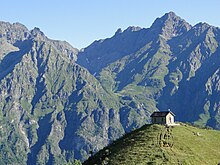
The orography of Lombardy is characterised by the presence of three distinct belts: a northern mountainous belt constituted by the Alpine relief, a central piedmont area of mostly pebbly soils of alluvial origin, and the Lombard section of the Padan Plain in the southernmost part of the region.
The most important mountainous area is the Alpine zone including the Lepontine and Rhaetian Alps (Piz Bernina, 4,020 m), the Bergamo Alps, the Ortler Alps and the Adamello massif. It is followed by the Alpine foothills zone Prealpi, the main peaks of which are the Grigna Group (2,410 m), Resegone (1,875 m), and Presolana (2,521 m).
The plains of Lombardy, formed by alluvial deposits, can be divided into the Alta—an upper, permeable ground zone in the north—and the Bassa—a lower zone dotted by the so-called line of fontanili, spring waters rising from impermeable ground. Inconsistent with the three distinctions above is the small subregion of Oltrepò Pavese, formed by the Apennine foothills beyond the Po River.
Hydrography

The mighty Po river marks the southern border of the region for a length of about 210 km (130 mi). In its progress, it receives the waters of the Ticino River, which rises in the Bedretto valley (Switzerland) and joins the Po near Pavia. The other streams which contribute to the great river are the Olona, the Lambro, the Adda, the Oglio and the Mincio.
The numerous lakes of Lombardy, all of glacial origin, lie in the northern highlands. From west to east these are Lake Maggiore, Lake Lugano (both shared with Switzerland), Lake Como, Lake Iseo, Lake Idro, and Lake Garda (the largest lake in Italy). South of the Alps lie the hills characterised by a succession of low heights of morainic origin formed during the last Ice Age and small barely fertile plateaux with typical heaths and conifer woods. A minor mountainous area, the Oltrepò Pavese, lies south of the Po, in the Apennines range.
Flora and fauna
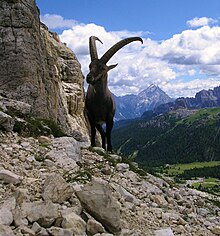
In the plains, intensively cultivated for centuries, little of the original environment remains. The most common trees are elm, alder, sycamore, poplar, willow and hornbeam. In the area of the foothills lakes, however, grow olive trees, cypresses and larches, as well as varieties of subtropical flora such as magnolias, azaleas, acacias. Numerous species of endemic flora in the Prealpine area include some kinds of saxifrage, the Lombard garlic, groundsels bellflowers and the cottony bellflowers.
The highlands are characterised by the typical vegetation of the whole range of the Italian Alps. At lower levels (up to approximately 1,100 m), oak woods or broadleafed trees grow; on the mountain slopes (up to 2,000–2,200 m), beech trees grow at the lowest limits, with conifer woods higher up. Shrubs such as rhododendron, dwarf pine and juniper are native to the summital zone (beyond 2,200 m).
Lombardy counts many protected areas: the most important are the Stelvio National Park (the largest Italian natural park), with typically alpine wildlife: red deer, roe deer, ibex, chamois, foxes, ermine and also golden eagles; and the Ticino Valley Natural Park, instituted in 1974 on the Lombard side of the Ticino River to protect and conserve one of the last major examples of fluvial forest in northern Italy.
Other Parks situated in the region are the Campo dei Fiori and the Cinque Vette Park, both of them are located in the Province of Varese.
Climate
Lombardy has a wide array of climates, due to local variances in elevation, proximity to inland water basins, and large metropolitan areas.

The climate of the region is mainly humid subtropical (Köppen Cfa) especially in the plains, though with significant variations to the Köppen model especially regarding the winter season, which in Lombardy is normally long, damp, and rather cold. In addition, there is a high seasonal temperature variation (in Milan, the average temperature is 2.5 °C (36.5 °F) in January and 24 °C (75 °F) in July). The plains are often subject to the presence of fog during the coldest months.
In the Alpine foothills, characterised by an oceanic climate (Köppen Cfb), numerous lakes exercise a mitigating influence, allowing the cultivation of typically Mediterranean crops (olives, citrus fruit).
In the hills and mountains, the climate is humid continental (Köppen Dfb). In the valleys it is relatively mild, while it can be severely cold above 1,500 m, with copious snowfalls.
Precipitation is more intense in the Prealpine zone, up to 1,500 to 2,000 mm (59.1 to 78.7 in) annually, but is abundant also in the plains and alpine zones, with an average of 600 to 850 mm (23.6 to 33.5 in) annually. The total annual rainfall is on average 827 mm.[13]
History
Prehistory and antiquity
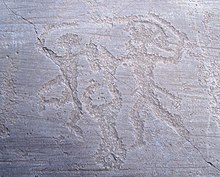
It is thought from the archaeological findings of ceramics, arrows, axes, and carved stones that the area of current Lombardy has been settled at least since the 2nd millennium BC. Well-preserved rock drawings left by ancient Camuni in the Valcamonica depicting animals, people, and symbols were made over a time period of eight thousand years preceding the Iron Age,[15] based on about 300,000 records.[16]
The many artifacts (pottery, personal items and weapons) found in necropolis near the Lake Maggiore, and River Ticino demonstrate the presence of the GolaseccaBronze Age culture that prospered in Western Lombardy between the 9th and the 4th century BC.
In the following centuries it was inhabited by different peoples, among whom were the Etruscans, who founded the city of Mantua and spread the use of writing. It was seat of the Celtic Canegrate culture (starting from the 13th Century BC) and later of the Celtic Golasecca culture. Later, starting from the 5th century BC, the area was invaded by more CelticGallic tribes coming from north of the Alps. These people settled in several cities including Milan, and extended their rule to the Adriatic Sea.
Their development was halted by the Roman expansion in the Po Valley from the 3rd century BC onwards. After centuries of struggle, in 194 BC the entire area of what is now Lombardy became a Roman province with the name of Gallia Cisalpina ("Gaul on the inner side (with respect to Rome) of the Alps").
The Roman culture and language overwhelmed the former civilisation in the following years, and Lombardy became one of the most developed and richest areas of Italy with the construction of a wide array of roads and the development of agriculture and trade. Important figures were born here, like Pliny the Elder (in Como) and Virgil (in Mantua). In late antiquity the strategic role of Lombardy was emphasised by the temporary moving of the capital of the Western Empire to Mediolanum (Milan). Here, in 313 AD, Roman Emperor Constantine issued the famous Edict of Milan that gave freedom of confession to all religions within the Roman Empire.
Kingdom of the Lombards

During and after the fall of the Western Empire, Lombardy suffered heavily from destruction brought about by a series of invasions by tribal peoples. The last and most effective was that of the Germanic Lombards, or Longobardi, whose whole nation migrated here from the Carpathian basin in fear of the conquering Pannonian Avars in 568 and whose long-lasting reign (with its capital in Pavia) gave the current name to the region. There was a close relationship between the Frankish, Bavarian and Lombard nobility for many centuries.
After the initial struggles, relationships between the Lombard people and the Latin-speaking people improved. In the end, the Lombard language and culture assimilated with the Latin culture, leaving evidence in many names, the legal code and laws, and other things. The genes of the Lombards became quickly diluted into the Italian population owing to their relatively small number and their geographic dispersal to rule and administer their kingdom.[17] The end of Lombard rule came in 774, when the Frankish king Charlemagne conquered Pavia, deposed Desiderius, the last Lombard king, and annexed the Kingdom of Italy (mostly northern and central present-day Italy) to his newly established Holy Roman Empire. The former Lombard dukes and nobles were replaced by other German vassals, prince-bishops or marquises.
Communes and the Empire

In the 10th century, Lombardy, although formally under the rule of the Holy Roman Empire like much of central and northern Italy, was in fact divided in a multiplicity of small, autonomous city-states, the medieval communes. The 11th century marked a significant boom in the region's economy, due to improved trading and, most importantly, agricultural conditions, with arms manufacture a significant factor. In a similar way to other areas of Italy, this led to a growing self-acknowledgement of the cities, whose increasing richness made them able to defy the traditional feudal supreme power, represented by the German emperors and their local legates. This process reached its apex in the 12th and 13th centuries, when different Lombard Leagues formed by allied cities of Lombardy, usually led by Milan, managed to defeat the Hohenstaufen Emperor Frederick I, at Legnano, but not his grandson Frederick II, at Battle of Cortenuova. Subsequently, among the various local city-states, a process of consolidation took place, and by the end of the 14th century, two signoria emerged as rival hegemons in Lombardy: Milan and Mantua.
Renaissance duchies of Milan and Mantua

In the 15th century, the Duchy of Milan was a major political, economical and military force at the European level. Milan and Mantua became two centres of the Renaissance whose culture, with men such as Leonardo da Vinci and Mantegna, and works of art (e.g. Leonardo da Vinci's The Last Supper) were highly regarded. The enterprising class of the communes extended its trade and banking activities well into northern Europe: "Lombard" designated the merchant or banker coming from northern Italy (e.g. Lombard Street in London). The name "Lombardy" came to designate the whole of Northern Italy until the 15th century and sometimes later. From the 14th century onwards, the instability created by the unceasing internal and external struggles ended in the creation of noble seigniories, the most significant of which were those of the Viscontis (later Sforzas) in Milan and of the Gonzagas in Mantua. This richness, however, attracted the now more organised armies of national powers such as France and Austria, which waged a lengthy battle for Lombardy in the late 15th to early 16th centuries.
Late-Middle Ages, Renaissance and Enlightenment

After the decisive Battle of Pavia, the Duchy of Milan became a possession of the Habsburgs of Spain: the new rulers did little to improve the economy of Lombardy, instead imposing a growing series of taxes needed to support their unending series of European wars. The eastern part of modern Lombardy, with cities like Bergamo and Brescia, was under the Republic of Venice, which had begun to extend its influence in the area from the 14th century onwards (see also Italian Wars). Between the middle of the 15th century and the battle of Marignano in 1515, the northern part of east Lombardy from Airolo to Chiasso (modern Ticino), and the Valtellina valley came under possession of the old Swiss Confederacy.
Pestilences (like that of 1628/1630[18] described by Alessandro Manzoni in his I Promessi Sposi) and the generally declining conditions of Italy's economy in the 17th and 18th centuries halted the further development of Lombardy. In 1706 the Austrians came to power and introduced some economic and social measures which granted a certain recovery.
Austrian rule was interrupted in the late 18th century by the French armies; under Napoleon, Lombardy became the centre of the Cisalpine Republic and of the Kingdom of Italy, both being puppet states of France's First Empire, having Milan as capital and Napoleon as head of state. During this period Lombardy took back Valtellina from Switzerland.
Modern era

The restoration of Austrian rule in 1815, as the Kingdom of Lombardy–Venetia, was characterised by the struggle with the new ideals introduced by the Napoleonic era.
The popular republic established by the 1848 revolution was short-lived, its suppression leading to renewed Austrian rule. This came to a decisive end when Lombardy was annexed to the Kingdom of Italy 1859 as a result of the Second Italian War of Independence from the Austrian Empire. When annexed to the Kingdom of Italy in 1859 Lombardy achieved its present-day territorial shape by adding the Oltrepò Pavese (formerly the southern part of Novara's Province) to the province of Pavia.
COVID-19 pandemic
The Lombardy region was severely affected by the COVID-19 pandemic in early 2020, in which Italy was one of the worst affected countries in Europe. Several towns were quarantined from 22 February after community transmission was documented in Lombardy and Veneto the previous day. The entire Lombardy region was placed under lockdown on 8 March,[19] followed by all of Italy the following day,[20] making Italy the first country to implement a nationwide lockdown in response to the epidemic, which was declared a pandemic by the World Health Organization on 11 March. The lockdown was ultimately extended twice, and the Lombardy region toughened restrictions on 22 March, banning outdoor exercise and the use of vending machines,[21] but from the beginning of May, following a reported decrease in the number of active cases, restrictions gradually began to be relaxed.[22]
Economy
As of 2013[update], the gross domestic product (GDP) of Lombardy, equal to over €350 billion, accounts for about 21% of the total GDP of Italy. By inhabitant, this figure results in a value of €33,066, which is more than 25% higher than the national average of €25,729.[23]
| 2000 | 2001 | 2002 | 2003 | 2004 | 2005 | 2006 | 2007 | 2008 | 2009 | 2010 | 2011 | 2012 | 2013 | 2014 | 2015 | 2016 | 2017 | 2018 | |
|---|---|---|---|---|---|---|---|---|---|---|---|---|---|---|---|---|---|---|---|
| GDP[24] (Euro) | 247.052 | 259.431 | 270.653 | 279.450 | 289.471 | 297.600 | 307.718 | 320.844 | 323.973 | 310.952 | 346.797 | 354.342 | 348.665 | 349.008 | 350.025 | 357.200 | 375.270 | 385.133 | 390.461 |
| GDP per capita[24] (Euro) | 27.488 | 28.766 | 29.837 | 30.449 | 31.060 | 31.545 | 32.356 | 33.443 | 33.425 | 31.743 | 35.713 | 36.220 | 35.367 | 35.127 | 35.044 | 35.700 | 37.474 | 38.407 | 38.858 |
Lombardy's development has been marked by the growth of the services sector since the 1980s, and in particular by the growth of innovative activities in the sector of services to enterprises and in credit and financial services. At the same time, the strong industrial vocation of the region has not suffered. Lombardy remains, in fact, the main industrial area of the country. The presence, and development, of a very high number of enterprises belonging to the services sector represents a favourable situation for the improvement of the efficiency of the productive process, as well as for the growth of the regional economy.

Lombardy has cultural and economical relationships with many foreign countries including Azerbaijan,[26] Austria,[27][28][29] France,[30] Hungary,[31][32][33][34][35] Switzerland (especially the cantons of Ticino and Graubünden),[36][37][38][39][40] Canada (the Province of Quebec),[41] Germany (the States of Bavaria, Saxony, and Saxony-Anhalt),[42][43][44]Kuwait ,[45] the Netherlands (Province of Zuid-Holland),[46] and Russia.[47] Lombardy is a member of the Four Motors of Europe, an intereuropean economical organization which includes Baden-Wurtenberg in Germany, Catalonia in Spain, and Auvergne-Rhône-Alpes in France.[48] The Lombardy region is also part of the EUSALP, which promotes innovation, green sustainability, and economy in the Alpine regions of Austria, France, Liechtenstein, Northern Italy, Southern Germany, Switzerland, and Slovenia,[49][50][51] and ARGE ALP, which gathers states located in the alpine regions of Austria, Northern Italy, Southern Germany, and Switzerland to discuss similar themes as in EUSALP.[52] Economical and cultural relationship are also strong with neighboring Italian regions Friuli-Venezia Giulia, South Tyrol, Trentino, and Veneto.[53][54][55][56][57][58][59][60][61][62][63] The European Union has developed the CENTRAL EUROPE program 2014–2020 to foster cooperation in several areas between the Lombardy Region along with other Northern Italian Regions and several states of Central Europe.[64][65]
The region can broadly be divided into three areas in regards to productive activity: Milan, where the services sector makes up for 65.3% of the employment; the provinces of Varese, Como, Lecco, Monza and Brianza, Bergamo and Brescia, where it is highly industrialised, although in the two latter provinces, there is also a rich agricultural sector in the plains; the provinces of Sondrio, Pavia, Cremona, Mantova and Lodi, where there is a consistent agricultural activity, and at the same time an above average development of the services sector.
Agriculture
The productivity of agriculture is enhanced by a well-developed use of fertilisers and the traditional abundance of water, boosted since the Middle Ages by the construction (partly designed by Leonardo da Vinci) of a wide net of irrigation systems. Lower plains are characterised by fodder crops, which are mowed up to eight times a year, cereals (rice, wheat and maize) and sugar beet. Productions of the higher plains include cereals, vegetables, fruit trees and mulberries. The higher areas, up to the Prealps and Alps sectors of the north, produce fruit and wine.
Lombardy is home of very intensive animal breading and is leading in dairy cows (36%) and pigs (50%) heritage. Cattle is source of quality milk (ca. 30% of Italian milk production),[66] which use to produce different types of cheese (4,715,130 t, ca. 36% of Italian total):[66]
Grana Padano (granular cheese)
Mascarpone (cream cheese)
Taleggio (semi-soft cheese)
Gorgonzola (blue-veined cheese)
Bitto (hard cheese)
Provolone Valpadana (pasta filata cheese)
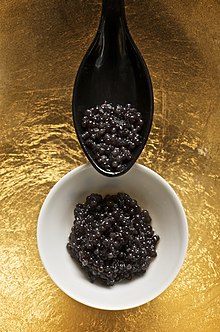
Vineyards cover 26,951 ha. The most important wine is sparkling wine DOCG Franciacorta which are produced with the same traditional method as Champagne in different to other Italian sparkling wines which use charmat method. Lombardy has rank 9 of 20 in production of DOC and DOCG wines with 877.351 hl[67]
Brescia is also the homeland of Italian caviar. In Calvisano, about 30 kilometres (19 mi) south of the city centre, is located the world's largest sturgeons farm[68] that produces annually 25 tonnes of caviar exported all over the world.[69]
The main activity in Canneto sull'Oglio is the nursery production of broad-leaved plants, to which a large part of the municipal agricultural land is destined. Together with the neighboring municipalities, the "Cannetese Nursery District" has been created which, on land covering approximately 2,500 hectares, produces an annual turnover of around 150 million euros.[70]
Aerospace and Defense
Italy is world leading exporter of heavy helicopters (over 2,000 kg) with market share ca. 30%.[71] Lombardy is home of Leonardo Helicopters Division responsible for ca. 1/3 company's orders[72] (ex-AgustaWestland) and plant of Leonardo Aircraft Division (ex-Aermacchi).[73] The main design, production and training facilities of helicopters located in Cascina Costa di Samarate, Vergiate and Sesto Calende. Aircraft Division manufactures military training aircraft in Venegono Superiore.[73]
In Gardone Val Trompia present the world oldest firearm manufacturer Beretta, there are also other manufacturer in the region like Tanfoglio, Pedersoli. Ammunition is delivered from Fiocchi. ex-OTO Melara, now part of Leonardo Electronics Division in Brescia produces small caliber naval and airborne weapons.[73]
Automotive
There is no car production at all. All factories of mass-market automotive manufacturers Alfa Romeo,[74]Autobianchi ,[75]Innocenti[76] are closed, abandoned or demolished. But there is production of light trucks Iveco Daily in Suzzara[77] and medium-duty trucks Iveco EuroCargo in Brescia.[78] Tractors are made by Same-Deutz Fahr (Same, Lamborghini) in Treviglio and BCS Group in Abbiategrasso.
Iveco Daily VII.Generation
Iveco EuroCargo IV.Generation
Motorcycles from Lombardy:
Moto Guzzi V85 TT (Piaggio)
Moto Guzzi V7 Classic (Piaggio)
MV Agusta Brutale 1090
The best-known automotive suppliers are Brembo, Bergamo (ceramic brake systems),[79]Pirelli , Milan (tyres)[80] and Magneti Marelli, Corbetta (electronic systems, powertrain).[81][79]
Electronics
The biggest European semiconductors company STMicroelectronics has 5,600 employees in suburban of Milan: Agrate Brianza (4,500 empl.) and Cornaredo (1,100 empl.) with R&D and production activity of chips for general purpose.[82]
SAES Getters, Lainate produces getters, alkaline metal dispensers, cathodes and materials for thermal management. The offered products are employed in various devices such as X-ray tubes, microwave tubes, solid state lasers, electron sources, photomultipliers, radiofrequency amplification systems, night vision devices, pressure sensors, gyroscopes for navigation systems and MEMS devices.[83]
Magneti Marelli has headquarters and manufactures automotive electronics in Corbetta.[81]
Leonardo Electronics Division in Nerviano designs and develops airborne radar and computers, space equipment.[73]
Candy Hoover[84] and Whirlpool (brands: Whirlpool, Indesit, Ariston, Hot Point, Ignis) make home appliances in Lombardy.
Fashion
Milan is one of the fashion capitals of the world, where the sector can count on 12,000 companies, 800 show rooms, and 6,000 sales outlets; the city hosts the headquarters of global fashion houses such as Armani, Dolce & Gabbana, Luxottica, Prada, Versace, Valentino, Zegna. The best-known high-class shopping district is Quadrilatero della moda.
Castel Goffredo, in the province of Mantua is known throughout the world as the "City of the stocking", the most important district for the production of women's hosiery. Other 14 community also belong to this district Acquafredda, Asola, Casalmoro, Casaloldo, Casalromano, Castiglione delle Stiviere, Ceresara, Isola Dovarese, Mariana Mantovana, Medole, Piubega, Remedello, Solferino and Visano.[70][circular reference]
Button industrial district of Grumello del Monte (Mabo Group).[70]
Lingerie industrial district of Val Camonica.[70]
Furniture
There is an industrial district of furniture around Brianza with annual turnover ca. 2 billion euros and 1,700 companies.[85] The furniture factories, which have about 40,000 employees, are mainly concentrated in Lissone (the first exhibition center in Europe since the 1960s), Meda, Cantù and Mariano Comense. Other important production centers are Giussano, Seveso and Seregno.[70]
This district has tight relation with Milan's metadistrict of design. In Milan take place a large furniture exhibitions "Salone del Mobile Milano".[86]
Unemployment
The unemployment rate stood at 5.0% in 2020. Regional unemployment was one of the lowest in Italy.[87]
Pollution
The Lombardy region in northern Italy ranks among the most air polluted areas of Europe.[88] Because of high industrialization and the lack of wind due to being closed between mountain ranges air pollution remains a severe problem in Lombardy and northern Italy.
In March 2019, the European Space Agency (ESA)[89] published images took from their satellites. These images show a big stain, made of nitrogen dioxide and fine particles, situated above the Po Valley area. The Lombardy region is the geographic and economic epicenter of this area, with more than 10 million residents and the highest gross domestic product per inhabitant of the country. Most of its major cities are located in the basin of the Po River, which crosses the entire region. The big stain analyzed by ESA is the main reason why Po valley air pollution levels are so high it is considered nowadays the worst area in Europe for air quality. Milan has high levels of ozone and nitrogen oxides, which are mainly produced by cars diesel and petrol engines.
To shed light on how dangerous it is for humans to live in polluted environments, Chicago Energy Policy Institute[90] has recently developed the Air Quality Life Index (AQLI), a system capable of analyzing air pollution worldwide. According to AQLI findings, Po valley air pollution affects inhabitants so hard that it cuts off about half a year of their life expectancy. The main reasons why there's a big stain of air pollution over the Po valley are strictly connected to livestock and factories. The so-called "NPK fertilizers", made of nitrogen, phosphorus and potassium, along with manure emissions from intensive breeding and high levels of nitrogen dioxide released by diesel and petrol engines are all accountable for this disastrous air condition in Northern Italy. The region of Lombardy produces also vast amounts of animal waste, a big contributor to pollution. It delivers more than 40 percent of Italy's milk production, for example, while over half of the Italian pig production is located in the Po Valley.[91]
According to a research, published in The Lancet Planetary Health[92] in January 2021, which estimates the death rate associated with fine particulate matter (PM2.5) and nitrogen dioxide (NO2) pollution in 1000 European cities, Brescia and Bergamo in Lombardy have the highest death rate from fine particulate matter (PM2.5) in Europe.
The data show that many cities in Lombardy and the Po Valley suffer the most serious impact at European level due to poor air quality, first of all the metropolitan area of Milan, thirteenth in the ranking in terms of fine particulate impact, where any year 3967 premature deaths – approximately 9% of the total.
Demographics
One-sixth of the Italian population or about 10 million people live in Lombardy (16.2% of the national population; 2% of the European Union population).
The population is highly concentrated in the Milan metropolitan area (2,029 inh./km2) and the Alpine foothills that compose the southern section of the provinces of Varese, Como, Lecco, Monza and Brianza and Bergamo, (1,200 inh./km2). A lower average population density (250 inh./km2) is found in the Po valley and the lower Brescia valleys; much lower densities (less than 60 inh./km2) characterise the northern mountain areas and the southern Oltrepò Pavese subregion.[23]
The growth of the regional population was particularly sustained during the 1950s–60s, thanks to a prolonged economic boom, high birth rates, and strong migration inflows (especially from Southern Italy). Since the 1980s, Lombardy has become the destination of a large number of international migrants, insomuch that today, more than a quarter of all foreign-born residents in Italy live in this region. As of 2016[update], the Italian national institute of statistics (ISTAT) estimated that 1,139,430 foreign-born immigrants live in Lombardy, equal to 11.4% of the total population. The primary religion is Catholicism; significant religious minorities include Christian Waldenses, Protestants and Orthodox, as well as Jews, Sikh and Muslims.
Government and politics
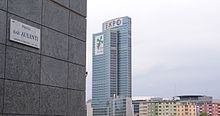
Politics in Lombardy is framed within a system of representative democracy, where the President of the Region (Presidente della Regione) is the head of government, and of a pluriform multi-party system. Executive power is vested in the Regional Government (Giunta Regionale) and legislative power is vested in the Regional Council (Consiglio Regionale).
Historically, the moderate Christian Democrats maintained a large majority of the popular support and the control of the most important cities and provinces from the end of the Second World War to the early 1990s. The opposition Italian Communist Party was a considerable presence only in southern Lombardy and in the working class districts of Milan; their base, however, was increasingly eroded by the rival centrist Italian Socialist Party, until eventually the Mani Pulite corruption scandal (which spread from Milan to the whole of Italy) wiped away the old political class and parties almost entirely.
This, together with the general disaffection towards the central government (considered as wasting resources to balance the budgets of the chronically underdeveloped regions of Southern Italy), led to the sudden growth of the secessionist Northern League, particularly strong in the mountain and rural areas. In the last twenty years, Lombardy stayed as a conservative stronghold, overwhelmingly voting for Silvio Berlusconi in all the six last general elections. Notwithstanding, the capital city of Milan elected progressive Giuliano Pisapia at the 2011 municipal elections and the 2013 regional elections saw a narrow victory for the center-right coalition.
On 22 October 2017 a non-binding autonomy referendum took place in Lombardy. The turnout was a low 38.3%, of which 95.3% voted in favor. The regional government of Lombardy is still under negotiation with Rome for the devolution of certain competencies.[94][95]
Administrative divisions
The region of Lombardy is divided in 11 administrative provinces, 1 metropolitan city and 1,530 communes.

| Rank | Province | Pop. | Rank | Province | Pop. | ||||
|---|---|---|---|---|---|---|---|---|---|
Milan Brescia | 1 | Milan | Milan | 1,396,059 | 11 | Cremona | Cremona | 72,672 | Monza Bergamo |
| 2 | Brescia | Brescia | 199,597 | 12 | Vigevano | Pavia | 63,623 | ||
| 3 | Monza | Monza | 124,051 | 13 | Legnano | Milan | 60,336 | ||
| 4 | Bergamo | Bergamo | 121,178 | 14 | Gallarate | Varese | 53,934 | ||
| 5 | Como | Como | 85,915 | 15 | Rho | Milan | 51,323 | ||
| 6 | Busto Arsizio | Varese | 83,909 | 16 | Mantua | Mantua | 49,440 | ||
| 7 | Sesto San Giovanni | Milan | 81,841 | 17 | Lecco | Lecco | 48,173 | ||
| 8 | Varese | Varese | 80,645 | 18 | Cologno Monzese | Milan | 48,030 | ||
| 9 | Cinisello Balsamo | Milan | 76,264 | 19 | Paderno Dugnano | Milan | 47,467 | ||
| 10 | Pavia | Pavia | 73,334 | 20 | Lissone | Monza | 46,445 |
Culture
Beside being an economic and industrial powerhouse, Lombardy has a rich and diverse cultural heritage. The many examples range from prehistory to the present day, through the Roman period and the Renaissance and can be found both in museums and churches that enrich cities and towns around the region. Major tourist destinations in the region include (in order of arrivals as of 2013[update])[97] the historic, cultural and artistic cities of Milan (4,527,889 arrivals), Bergamo (242,942), Brescia (229,710), Como (215,320), Varese (107,442), Mantua (88,902), Monza (75,839) and the lakes of Garda (429,376), Como (322,585), Iseo (123,337) and Maggiore (71,055).
UNESCO World Heritage Sites

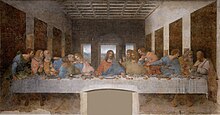


There are nine UNESCO World Heritage sites wholly or partially located in Lombardy.[98] Some of these comprise several individual objects in different locations. One of the entries has been listed as natural heritage and the others are cultural heritage sites.
At Monte San Giorgio, on the border with Swiss canton Ticino just south of Lake Lugano, a wide range of marine Triassic fossils have been found. During the Triassic period, some 240 million years ago, the area was a shallow tropical lagoon. Fossils include reptiles, fish and crustaceans and also some insects.
Two sites are of pre-historic origin. The Rock Drawings in Valcamonica date back to a period between 8000BC and 1000BC, covering prehistoric periods from the Epipaleolithic/Mesolithic to the Iron Age. The engravings show depictions of a wide range of topics including agricultural and war scenes alongside more abstract symbols.
The multi-centred heritage site Prehistoric pile dwellings around the Alps includes 111 individual objects in France, Switzerland, Italy, Germany, Austria and Slovenia, of which ten are located in Lombardy. Each of these objects consists of remnants of buildings erected on wooden piles in sub-alpine rivers, lakes and wetlands, built between 5000BC and 500BC. In general, only the submerged wooden parts have been preserved in the alluvial sediment, although in some places pile buildings have been reconstructed.
Another multi-centred site, Longobards in Italy, Places of Power (568–774 A.D.), comprises seven locations across mainland Italy which illustrate the history of the Lombard period which has given the region its name. Two of the individual sites are in the modern region of Lombardy: the fortifications (the castrum and the Torba Tower) and the church of Santa Maria foris portas ("outside the gates") with its Byzantinesque frescoes at Castelseprio, and the monastic complex of San Salvatore-Santa Giulia at Brescia. The UNESCO site of Brescia also includes the remains of its Roman forum, the best-preserved in Northern Italy.[99][100]
The Church and Dominican Convent of Santa Maria delle Grazie in Milan with "The Last Supper" by Leonardo da Vinci represent architectural and painting styles of the Renaissance period of the 15th century. The towns of Mantua and Sabbioneta are also listed as a combined World Heritage site relating to this period, here focussing more on town planning aspects of the time than on architectural detail. While Mantua was rebuilt in the 15th and 16th centuries according to Renaissance principles, Sabbioneta was planned as a new town in the 16th century.
The Sacri Monti of Piedmont and Lombardy are a group of nine sites in northwest Italy, of which two are in Lombardy. The concept of holy mountains can also be found elsewhere in Europe. These sites were created as centres of pilgrimage by placing chapels in the natural landscape and were loosely modelled on the topography of Jerusalem. In Lombardy, Sacro Monte del Rosario di Varese and Sacro Monte della Beata Vergine del Soccorso, built in the early to mid-17th century, mark the architectural transition from the late Renaissance to the Baroque style.
Crespi d'Adda is a company town founded in 1878 to accommodate workers of a local textile mill. At its height, the town was home to 3,200 employees and their families.
Parco Naturalistico-Archeologico della Rocca di Manerba del Garda, a fortress of Manerba del Garda.
The Rhaetian Railway in the Albula/Bernina Landscapes is mostly located in the Swiss canton Graubünden, but also extends over the border into Tirano. The site is listed because of the complex railway engineering (tunnels, viaducts and avalanche galleries) necessary to take the narrow-gauge railway across the main chain of the Alps. The two railway lines were opened in several stages between the years of 1904 and 1910.
The Venetian Works of Defence between the 16th and 17th centuries: Stato da Terra – western Stato da Mar is a transnational system of fortifications built by the Republic of Venice on its mainland domains (Stato da Terra) and its territories stretching along the Adriatic coast (Stato da Mar). This site includes the Fortified City of Bergamo.
Museums
Lombardy contains numerous museums (over 330) of different types (e.g. ethnographic, historical, technical-scientific, artistic and naturalistic) which testify to the historical-cultural and artistic development of the region. Among the most famous ones are the National Museum of Science and Technology "Leonardo da Vinci" (Milan), the Accademia Carrara (Bergamo), the Mille Miglia, the Santa Giulia Museum (both in Brescia), the Volta Temple, the Villa Olmo (both in Como), the Stradivari Museum (Cremona), the Palazzo Te (Mantua), the Museum Sacred Art of the Nativity, the Basilica of Santa Maria Assunta (both in Gandino), and the Royal Villa of Monza (Monza).
Other sights



- Cathedral of Milan
- Castello Sforzesco, Milan
- Basilica di Sant'Ambrogio, Milan
- Teatro alla Scala, Milan
- Basilica of San Lorenzo, Milan
- Basilica of Sant'Eustorgio, Milan
- Brera Gallery, Milan
- Bellagio
- Accademia Carrara, Bergamo
- Santa Maria Maggiore and Cappella Colleoni, Bergamo
- The fortified Venetian walls, Bergamo
- Roman and Longobard monuments in Brescia
- Duomo Nuovo, Brescia
- Castelseprio archaeological site
- Certosa di Pavia
- Como Cathedral and Basilica of Sant'Abbondio, Como
- Duomo and Torrazzo, Cremona
- Lake Como
- Lake Garda
- Lake Iseo
- Tempio Civico della Beata Vergine Incoronata, Lodi
- Royal Villa of Monza
- San Pietro in Ciel d'Oro and San Michele Maggiore, Pavia
- Villa Toeplitz, Varese
Cuisine
Rice is popular in the region, often found in soups as well as risotti, such as "risotto alla milanese", with saffron. In the city of Monza, a popular recipe also adds pieces of sausages to the risotto. Polenta is also common throughout the region. Regional cheeses include Robiola, Crescenza, Taleggio, Gorgonzola and Grana Padano (the plains of central and southern Lombardy allow intensive cattle-raising). Butter and cream are used. Single pot dishes, which take less work to prepare, are popular. Common types of pasta include Casoncelli in Brescia and Bergamo and Pizzoccheri in Valtellina. In Mantua, festivals feature tortelli di zucca (ravioli with pumpkin filling) accompanied by melted butter and followed by turkey stuffed with chicken or other stewed meats.[101] Among typical regional desserts is Nocciolini di Canzo—dry biscuits.

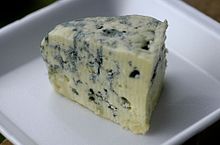
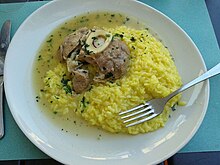
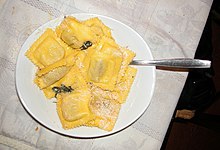
- Casoncelli
- Carpaccio di Bresaola
- Pizzoccheri (tagliatelle of buckwheat and wheat, laced with butter, green vegetables, potatoes, sage and garlic, topped with Casera cheese)
- Risottoalla milanese
- Tortelli di zucca (pumpkin-filled pasta)
- Polenta (eaten also in its taragna variant in the Northern part of the region)
- Ossobuco
- Cotoletta (cutlet) alla milanese
- Cassoeula
- Lo Spiedo Bresciano – spit roast of different cuts of meat with butter and sage
- Salamella (Italian Sausage without fennel or anise, always served grilled)
- Salame d'oca di Mortara (goose salami)
- Gorgonzola cheese
- Taleggio cheese
- Stracchino cheese
- Bitto cheese
- Rosa Camuna cheese
- Grana Padano cheese
- Mascarpone
- Panettone
- Sbrisolona cake
- Amaretti di Saronno
- Torrone
- Mostarda
- Franciacorta
- Nebbiolo red
- Bellavista
- Santi
- Nino Negri
- Bonarda Lombardy
- Inferno (Valtellina)
- Grumello (Valtellina)
- Sassella (Valtellina)
Music

Besides Milan, the region of Lombardy has 11 other provinces, most of them with equally great musical traditions. Bergamo is famous for being the birthplace of Gaetano Donizetti and home of the Teatro Donizetti; Brescia hosts the impressive 1709 Teatro Grande; Cremona is regarded as the birthplace of the commonly used violin and is home to several of the most prestigious luthiers in the world; and Mantua was one of the founding and most important cities in 16th- and 17th-century opera and classical music.
Other cities such as Lecco, Lodi, Varese and Pavia also have rich musical traditions, but Milan is the hub and centre of the Lombard musical scene. It was the workplace of Giuseppe Verdi, one of the most famous and influential opera composers of the 19th century, and boasts a variety of acclaimed theatres, such as the Piccolo Teatro and the Teatro Arcimboldi; however, the most famous is the 1778 Teatro alla Scala, one of the most important and prestigious operahouses in the world.
Language
Lombard is widely used in Lombardy, in diglossia with Italian. Lombard is a language[102] belonging to the Gallo-Italic group, within the Romance languages.[103] It is a cluster of homogeneous varieties used by at least 3,500,000 native speakers in Lombardy and some areas of neighbouring regions, notably the eastern side of Piedmont and Southern Switzerland (cantons of Ticino and Graubünden).[103]
The Lombard language should not be confused with that of the Lombards – Lombardic language, a Germanic language extinct since the Middle Ages.
Fashion
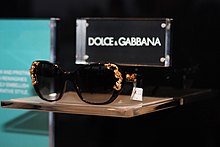
Lombardy has always been an important centre for silk and textile production, notably the cities of Pavia, Vigevano and Cremona, but Milan is the region's most important centre for clothing and high fashion. In 2009, Milan was regarded as the world fashion capital, even surpassing New York, Paris and London.[104] Most of the major Italian fashion brands, such as Valentino, Versace, Prada, Armani and Dolce & Gabbana, are currently headquartered in the city.
Sports
The most famous sport in Lombardy, as in all Italy, is football. In fact, Lombardy is home to some of the most important football teams in the country. Considering the 2020-21 Serie A season, Lombardy hosts 3 out of 20 teams: A.C. Milan and Inter Milan (both based in Milan) and Atalanta B.C. (based in Bergamo). Other big teams of the region are Brescia Calcio, A.C. Monza and U.S. Cremonese (playing in the 2020-21 Serie B) and Calcio Lecco 1912, U.C. AlbinoLeffe, Como 1907, Aurora Pro Patria 1919, A.C. Renate, A.S. Giana Erminio, S.S.D. Pro Sesto and U.S. Pergolettese 1932 (playing in the 2020-21 Serie C).
Olimpia Milano (based in Milan) is the most successful basketball team in Italy. In the 2020–21 LBA season 5 teams out of 15 are from Lombardy (Olimpia Milano, Pallacanestro Brescia, Pallacanestro Varese, Pallacanestro Cantù, Guerino Vanoli Basket).
The region's city Milan will host the 2026 Winter Olympics alongside Cortina d'Ampezzo.
The Autodromo Nazionale di Monza, located outside of Milan, hosts the Formula One Italian Grand Prix.
The Giro d'Italia, a famous annual bicycle race, usually ends in Milan.
For the region is also important alpine ski, the FIS Alpine Ski World Cup annually has a race in Bormio.
Twinning and covenants
See also
References
- "Lombardia, Lombardia, presentato l'inno della Regione". Corriere della Sera (in Italian). 22 December 2014.
- "Monthly demographic balance, January–June 2013". Demo.istat.it. Retrieved 30 November 2013.
- "Regional GDP per capita ranged from 30% to 263% of the EU average in 2018" (Press release). ec.europa.eu. Retrieved 1 September 2020.
- "OECD Statistics". stats.oecd.org. Retrieved 2 September 2019.
- "Sub-national HDI - Area Database - Global Data Lab". hdi.globaldatalab.org. Retrieved 13 September 2019.
- "Lombardy". The American Heritage Dictionary of the English Language (5th ed.). Boston: Houghton Mifflin Harcourt. Retrieved 7 July 2019.
- "Lombardy". Collins English Dictionary. HarperCollins. Retrieved 7 July 2019.
- "EUROPA Press Releases – Regional GDP per inhabitant in the EU27, GDP per inhabitant in 2006 ranged from 25% of the EU27 average in Nord-Est in Romania to 336% in Inner London". Europa (web portal). 19 February 2009. Retrieved 10 May 2010.
- OECD Data Synthesis.
- Eurostat – Functional urban areasArchived 16 April 2010 at the Wayback Machine.
- List of World Heritage Sites by country.
- Partridge, Eric (2009). Origins: an etymological dictionary of modern English ([Paperback ed.] ed.). London: Routledge. ISBN978-0415474337 .
- "Regional Statistical Yearbook: average rainfall, yearly and ten-year average, Lombardy and its provinces". Regione Lombardia. Archived from the original on 23 September 2015. Retrieved 21 July 2015.
- "Rock Drawings in Valcamonica – UNESCO World Heritage Centre". UNESCO. Retrieved 29 June 2010.
- Piero Adorno, Mesolitico e Neolitico, p. 16.
- "Introduzione all'arte rupestre della Valcamonica". Archeocamuni.it (in Italian). Retrieved 11 May 2009.
- Maciamo Hay (July 2013). "Genetic History of the Italians". Eupedia. Retrieved 22 January 2019.
- "Storia di Milano ::: Gian Giacomo Mora". Storiadimilano.it.
- "Italy announces quarantine affecting quarter of population". CNBC. 8 March 2020.
- Business, Hanna Ziady, CNN. "Italy just locked down the world's 8th biggest economy. A deep recession looms". CNN.
- "Italy's worst-hit region introduces stricter measures". BBC News. 22 March 2020.
- "Anger as Italy slowly emerges from long Covid-19 lockdown | Italy | The Guardian". amp.theguardian.com.
- "Regional Statistical Yearbook 2014"(PDF) . Regione Lombardia. Archived from the original(PDF) on 23 September 2015. Retrieved 21 July 2015.
- Dati Istat consultati il 15 giugno 2016. Nota: per visualizzare i dati occorre selezionare nella colonna a destra la voce Conti nazionali, Conti e aggregati economici territoriali, Valori procapite (euro) e in tabella selezionare la voce prodotto interno lordo ai prezzi di mercato per abitante (edizione novembre 2015) valutazione a prezzi correnti.
- OECD. "Competitive Cities in the Global Economy"(PDF) . Archived from the original(PDF) on 1 October 2008. Retrieved 30 April 2009.
- "Italian official: Azerbaijan has obtained impressive achievements [PHOTO]". AzerNews.az. 6 December 2018.
- "Design, in Lombardia crescono gli scambi con l'Austria". Giornalemetropolitano.it. Retrieved 27 October 2018.
- "Accordo IED-Camera Commercio Austriaca, vice presidente Regione: nuova opportunità di sviluppo".
- "Expo Milano – Regione Lombardia". Ambvienna.esteri.it. Retrieved 27 October 2018.
- "Milano, Attilio Fontana incontra l'ambasciatore francese: "Distendere gli animi tra Italia e Francia"". Corriere della Sera. 14 June 2018. Retrieved 27 October 2018.
- "Regione Lombardia, il presidente Fontana riceve il ministro degli affari esteri ungherese". BresciaToday.
- "Ungheria, Fontana riceve ministro Esteri a Palazzo Lombardia". 5 December 2018.
- "Il Console Generale è stato accolto dal Presidente della Regione di Lombardia – Consolato Generale di Ungheria Milano". Milano.mfa.gov.hu. Retrieved 27 October 2018.
- "Lecco: cresce l'export sul mercato ungherese – Tecnologie del Filo". Tecnologiedelfilo.it. Archived from the original on 9 September 2018. Retrieved 27 October 2018.
- "Delegazione Ungherese in visita di studio in Italia – :. ERSAF – Ente Regionale per i Servizi all' Agricoltura e alle Foreste:Regione Lombardia ". Ersaf.lombardia.it. Archived from the original on 9 September 2018. Retrieved 27 October 2018.
- "[Comunicato stampa Giunta regionale Lombardia] CANTON TICINO, FONTANA E ASSESSORI INCONTRANO DELEGAZIONE SVIZZERA:SUL TAVOLO INFRASTRUTTURE, TRASPORTI E AMBIENTE". Regioni.it. 31 July 2018. Retrieved 27 October 2018.
- "Rivedere l'accordo fiscale". Prealpina.it. 31 July 2018. Retrieved 27 October 2018.
- "Fontana: "I rapporti con la Svizzera vanno intensificati"". Varesenews.it. 16 April 2018. Retrieved 27 October 2018.
- swissinfo.ch, S. W. I.; Corporation, a branch of the Swiss Broadcasting. "GR: Milano, trasporto transfrontaliero, incontro Grigioni-Lombardia". TVSvizzera.
- "Tra Lombardia e Grigioni massima collaborazione, anche per le Olimpiadi". VareseNews. 24 September 2019.
- "Political and institutional relations". MRIF – Ministère des Relations internationales et de la Francophonie. Retrieved 27 October 2018.
- "Baviera partner ship Lombardia". Newsfood.com. 15 June 2018. Retrieved 27 October 2018.
- "Archived copy". Archived from the original on 26 August 2018. Retrieved 25 August 2018.
- "Incontro del Consiglio regionale lombardo con delegazione parlamentare della Bassa Sassonia". Giornalemetropolitano.it. Retrieved 27 October 2018.
- "KUNA : Kuwait works to boost cooperation with Italy's northern provinces, Lombardy - Politics - 13/07/2018". 15 July 2018. Archived from the original on 15 July 2018.
- "Province of Zuid-Holland intensifies water cooperation with Lombardy, Italy | Dutch Water Sector". www.dutchwatersector.com.
- "Tavola rotonda Lombardia-Russia, Fontana: "Collaborazione importante per il nostro territorio"". BresciaToday.
- Casqueiro, Javier (4 July 2018). "Borrell ordena a todas las embajadas responder a las "lindezas" independentistas contra España". El País. Retrieved 27 October 2018.
- "Action Group 1". EUSALP. 17 November 2016.
- "Presidenza Italiana EUSALP 2019".
- "Il timone di Eusalp passa dal Tirolo alla Lombardia". 22 November 2018.
- "Chi siamo – Arge Alp". it.argealp.org.
- "Olimpiadi 2026 e Fondi di confine, si rafforza la collaborazione fra Trentino e Lombardia". 2 May 2019.
- Trento, Redazione (4 May 2019). "Trentino e Lombardia: si rafforza la sinergia per le Olimpiadi 2026".
- "www.ladigetto.it – Trentino e Lombardia: si rafforza la collaborazione". ladigetto.it.
- "PAT * Trentino e Lombardia: "Incontro a Milano tra i presidenti Fugatti e Fontana, si rafforza la collaborazione"". 2 May 2019.
- "Fontana incontra Fugatti: Collaborazione tra Lombardia e Trentino". 2 May 2019.
- "Regione del Veneto". Regione del Veneto.
- "Lombardia Quotidiano". Lombardia Quotidiano. 19 October 2018.
- "Lombardia e Friuli Venezia Giulia due regioni a confronto". valtellinanews.it.
- "Parco dello Stelvio, intesa Trentino, Alto Adige e Lombardia sulla biodiversità – Cronaca". Trentino.
- SPA, Südtiroler Informatik AG | Informatica Alto Adige. "News & Media | Provincia autonoma di Bolzano – Alto Adige". Amministrazione provinciale.
- "Lombardia, Veneto e Trentino: "Regole comuni per la pesca su tutto il lago di Garda"". l'Adige.it. 4 April 2019.
- "Il Programma Central Europe 2014-2020".
- "Discover Interreg CENTRAL EUROPE". Interreg CENTRAL EUROPE.
- "Produzione industriale di latte alimentare, di burro e di formaggio" (in Italian).
- "Weinbau in Zahlen 2019"(PDF) . V.Q.P.R.D. d'Italia 2019 (in Italian). federdoc.com. Retrieved 25 November 2020.
- Black, Jane (26 September 2006). "Caviar from farms instead of the seas". The New York Times. Retrieved 31 July 2015.
- "E' Brescia la capitale mondiale del caviale" [Brescia is the world capital of caviar]. quibrescia.it (in Italian). 26 March 2015. Retrieved 31 July 2015.
- "Italian industrial district" (in Italian).
- "Who exported Helicopters >2,000kg in 2018?".
- "Leonardo Reports 2020".
- "Leonardo Location".
- "Lo Stabilimento di Arese" (in Italian).
- "MA L' AUTOBIANCHI SALUTA E VA IN GARAGE" (in Italian).
- "L'EX STABILIMENTO INNOCENTI: DALLA LAMBRETTA ALLA SCALA" (in Italian).
- "Daily tour plant suzzara" (in Italian).
- "Dove nasce Eurocargo".
- "The biggest italian automotive component manufacturers".
- "The largest tyre manufacturers worldwide".
- "Magneti Marelli Location".
- "agrate lavoro" (in Italian).
- "A hidden champion of the 21st century: SAES Getters".
- "The Chinese group Haier acquires Candy".
- "Brianza furniture district".
- "Salone del Mobile Milano".
- "Regional Unemployment by NUTS2 Region". Eurostat.
- "Air pollution exposure, cause-specific deaths and hospitalizations in a highly polluted Italian region". Retrieved 22 February 2021.
- "Nitrogen dioxide over northern Italy". Retrieved 28 January 2021.
- "Air pollution hotspots in Europe". Retrieved 29 January 2021.
- "Italy's polluted Po Valley gasps for fresh air". Retrieved 31 January 2021.
- "Premature mortality due to air pollution in European cities: a health impact assessment". Retrieved 27 January 2021.
- "Foreign Citizens. Resident Population by sex and citizenship on 31st December 2019". National Institute of Statistics. Retrieved 22 May 2021.
- "Archived copy". Archived from the original on 3 August 2018. Retrieved 2 August 2018.
- Giorno, Il. "Autonomia Lombardia, Fontana: consegnato al ministro dossier con le prime 15 materie – Il Giorno". Il Giorno. Italy. Retrieved 27 October 2018.
- "Lomabrdy (Italy). Resident population on 31 December 2019 by territory". tuttitalia.it. Istat. Retrieved 25 September 2020.
- "RSY Lombardia-Arrivals and nights spent by guests in accommodation establishments, by type of resort and by type of establishment. Total accommodation establishments. Part III Tourist resort. Year 2013". Asr-lombardia.it. Archived from the original on 3 May 2015. Retrieved 31 May 2015.
- "World Heritage List". UNESCO World Heritage Centre. UNESCO. Retrieved 16 May 2015.
- "Italia langobardorum, la rete dei siti Longobardi italiani iscritta nella Lista del Patrimonio Mondiale dell'UNESCO" [Italia langobardorum, the network of the Italian Longobards sites inscribed on the UNESCO World Heritage List]. Beniculturali.it (in Italian). Retrieved 27 October 2015.
- "THE LONGOBARDS IN ITALY. PLACES OF THE POWER (568–774 A.D.). NOMINATION FOR INSCRIPTION ON THE WORLD HERITAGE LIST"(PDF) . UNESCO. Retrieved 27 October 2015.
- Piras, 87.
-
"Documentation for ISO 639 identifier: LMO".
Identifier: LMO / Name: Lombard / Status: Active / Code set: 639-3 / Scope: Individual / Type: Living
-
Jones, Mary C.; Soria, Claudia (2015). "Assessing the effect of official recognition on the vitality of endangered languages: a case of study from Italy". Policy and Planning for Endangered Languages. Cambridge, UK: Cambridge University Press. p. 130. ISBN9781316352410 .
Lombard (Lumbard, ISO 639-9 lmo) is a cluster of essentially homogeneous varieties (Tamburelli 2014: 9) belonging to the Gallo-Italic group. It is spoken in the Italian region of Lombardy, in the Novara province of Piedmont, and in Switzerland. Mutual intelligibility between speakers of Lombard and monolingual Italian speakers has been reported as very low (Tamburelli 2014). Although some Lombard varieties, Milanese in particular, enjoy a rather long and prestigious literary tradition, Lombard is now mostly used in informal domains. According to Ethnologue, Piedmontese and Lombard are spoken by between 1,600,000 and 2,000,000 speakers and around 3,500,000 speakers, respectively. These are very high figures for languages that have never been recognised officially nor systematically taught in school
- "The Global Language Monitor " Fashion". Languagemonitor.com. 20 July 2009. Archived from the original on 1 November 2009. Retrieved 3 January 2010.
Further reading
- Cochrane, Eric. Historians and historiography in the Italian Renaissance (U of Chicago Press, 1981).
- Conca Messina, Silvia A., and Catia Brilli. "Agriculture and nobility in Lombardy. Land, management and innovation (1815-1861)." Business History (2019): 1-25.
- de Klerck, Bram. The Brothers Campi: Images and Devotion. Religious Painting in Sixteenth-Century Lombardy (Amsterdam UP. 1999).
- Di Tullio, Matteo. "Cooperating in time of crisis: war, commons, and inequality in Renaissance Lombardy." Economic History Review 71.1 (2018): 82-105.
- Di Tullio, Matteo. The wealth of communities: war, resources and cooperation in Renaissance Lombardy (Ashgate, 2014).
- Gamberini, Andrea. The Clash of Legitimacies: The State-Building Process in Late Medieval Lombardy (2018) online
- Greenfield, Kent Roberts. Economics and liberalism in the Risorgimento: a study of nationalism in Lombardy, 1814-1848 (1934).
- Klang, Daniel M. "Cesare Beccaria and the clash between jurisprudence and political economy in eighteenth-century Lombardy." Canadian journal of history 23.3 (1988): 305–336.
- Klang, Daniel M. "The problem of lease farming in eighteenth-century Piedmont and Lombardy." Agricultural history 76.3 (2002): 578-603 online.
- Klang, Daniel M. Tax reform in eighteenth century Lombardy (1977) online
- Messina, Silvia A. Conca. Cotton Enterprises: Networks and Strategies: Lombardy in the Industrial Revolution, 1815-1860 (2018) excerpt
- Pyle, Cynthia Munro. Milan and Lombardy in the Renaissance: Essays in cultural history (1997).
- Sella, Domenico. Crisis and continuity : the economy of Spanish Lombardy in the seventeenth century (1979) online
- Soresina, Marco. "Images of Lombardy in historiography." Modern Italy 16.1 (2011): 67–85.
- Storrs, Christopher. "The Army of Lombardy and the Resilience of Spanish Power in Italy in the Reign of Carlos II (1665-1700) (Part I)." War in History 4.4 (1997): 371–397.
Guide books
- Daverio, Philippe. Lombardy: 127 Destinations For Discovering Art, History, and Beauty (2016) guide book. excerpt
- Macadam, Alta, and Annabel Barber. Blue Guide Lombardy, Milan & the Italian Lakes (2020) excerpt
- Williams Jr., Egerton R. Lombard Towns in Italy; Or, The Cities of Ancient Lombardy (1914) online